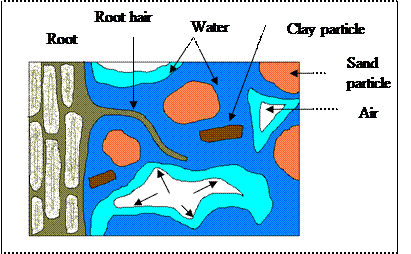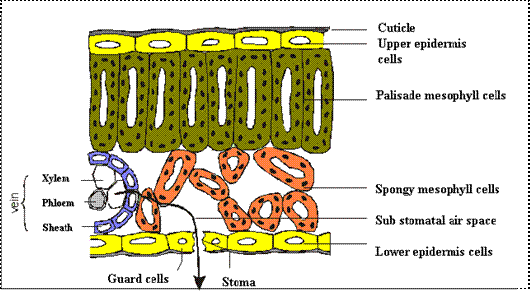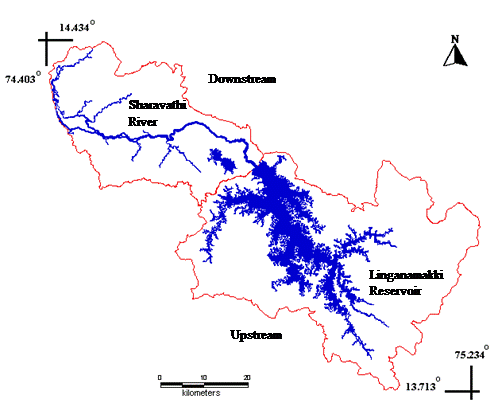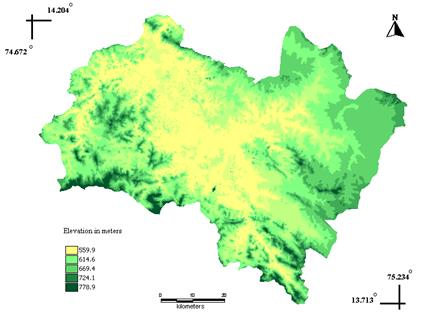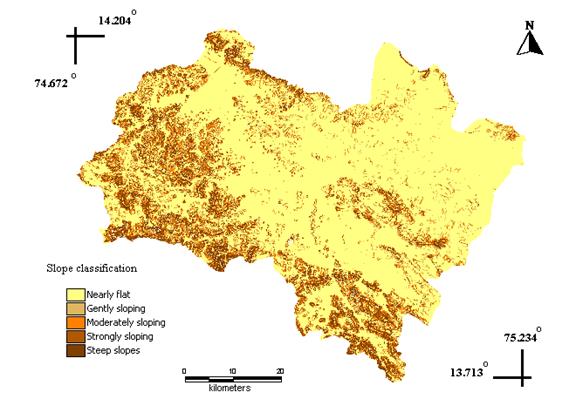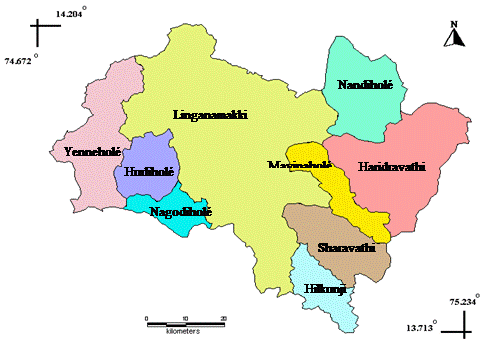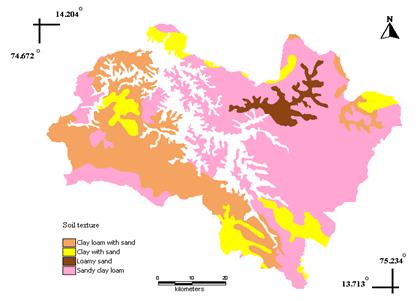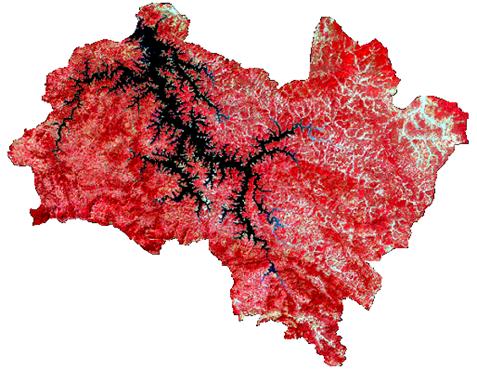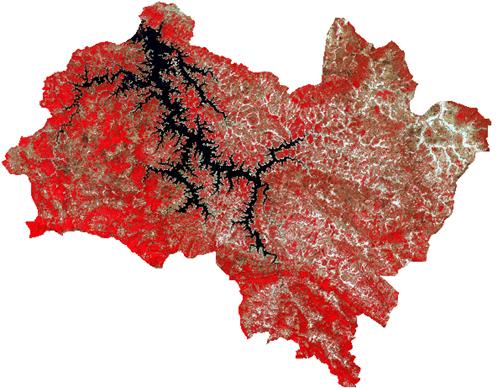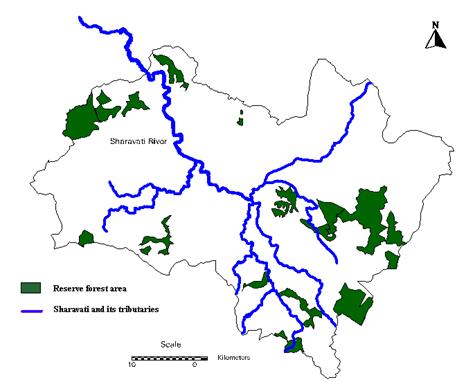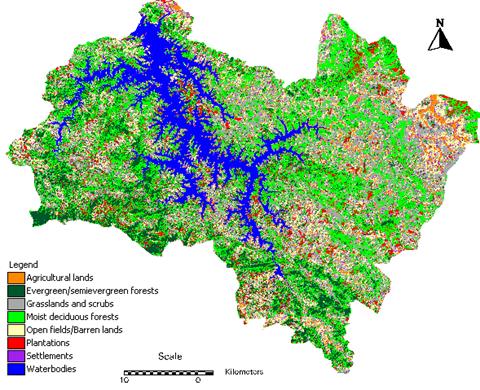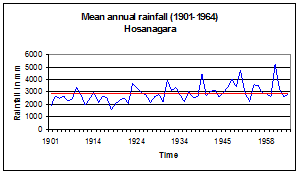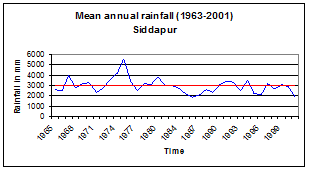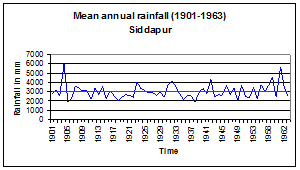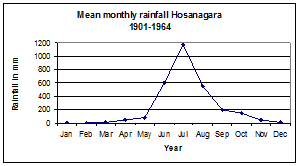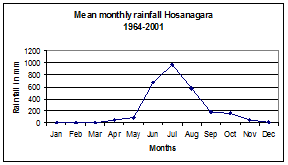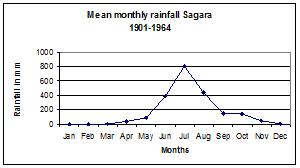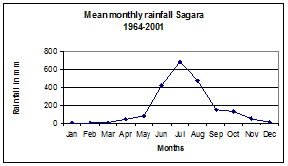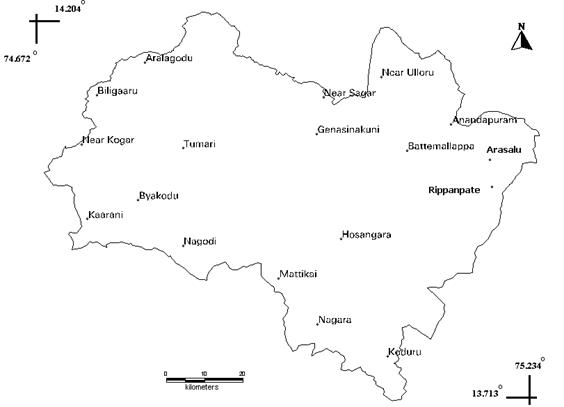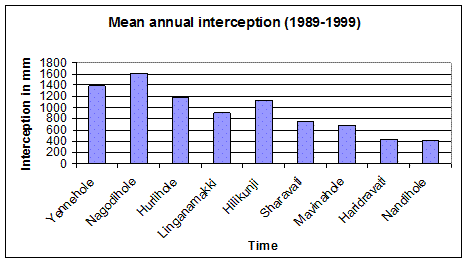Land use/Land cover maps of Sharavathi river basin (upstream) for 1989 and 1999 are given in Figure 5.2 and 5.3 Figure 5.2: Land use Classification (Landsat TM, 1989)
Figure 5.3: Land use Classification (IRS LISS III, 1999)
Results of Error Matrix (Landsat TM, 1989)Table 5.2: Error Matrix (Landsat TM, 1989)
Note: Evg/SE - evergreen/semievergreen forests; MD – moist deciduous forests; Plant – plantations; Grass – grasslands and scrubs; Agri – agricultural lands; Open – open fields; Sett- settlements Overall accuracy = 96.4% Results of Error Matrix (IRS LISS III, 1999)Table 5.3: Error Matrix (IRS LISS III, 1999)
Note: Evg/SE - evergreen/semievergreen forests; MD – moist deciduous forests; Plant – plantations; Grass – grasslands and scrubs; Agri – agricultural lands; Open – open fields; Sett- settlements Overall accuracy = 97.6% Low accuracy for settlements from both the imageries is partly due to spectral signature overlap with vegetation as most of the houses are surrounded by vegetation inside and outside the compound. Townships are few and houses are sparsely distributed separated by hundreds of meters. Since the building material is also different as almost all houses have tiled roof than concrete, overlap also occurred between open fields. Overlap of spectral signatures was also observed between evergreen/semievergreen forest and moist deciduous forests in full leaf. Table 5.4 compares the percentage change in the land use in Sharavathi upstream river basin. Table 5.4: Changes in Land use in Upstream (1989-1999)
From Table 5.4, it is seen that natural forests such as evergreen/semi-evergreen and moist deciduous forests have decreased by 28.2% whereas monoculture plantations (due to afforestation work of the forest department) have increased by 17.3%. Grasslands and scrubs have decreased by 28.4% in 1999 but this can be attributed to the season as in summer, grasses dry out leaving only the scrubs. The main anthropogenic activity apart from plantation is paddy cultivation, which has increased by 5% in 1999. Paddy cultivation is the most common agricultural activity in the basin and is usually grown in valleys. Shimoga ranks first among the other districts of the state as far as paddy is concerned (KSG, 1975). Human population has also increased in the basin and has been reported that there has been immigration of people from adjoining districts of Karnataka and also from neighbouring States (KSG, 1975). In recent years, few people from drought affected districts of Gulbarga and Bidar to Shimoga district to work on daily wages. A large number of seasonal in-migrants visit the villages at different seasons of the year. They arrive in large numbers in October-November and continue to stay there upto the end of about February-March. Some factory workers from Bhadravati town also come to villages to work on the agricultural lands during peak harvesting season. Another major activity that has been beneficial to the villages in Sharavathi and also adjoining districts is the setting up of the Linganamakki Dam across the Sharavathi River. The Sharavathi Hydroelectric Project formerly known as Honnemaradu Project was taken up by the State Government in 1956, to utilize the potential of the river. It has been one of the important undertakings of the state in the field of economic development (KSG, 1975). A dam of nearly 2.4 kms long has been put across this river at Linganamakki in Sagar taluk of Shimoga district. It was so designed as to impound 4368 million cubic meter of water in an area of around 300 km2, submerging 50.62 km2 of wetland, 7 km2 of dry land and 3.9 km2, the remaining being forest land and wasteland. Although the dam has provided electricity, water and other benefits to the surrounding areas, it has proved to be at the cost of the valuable ecosystem. Evergreen forests are being cleared to yield timber, which are used for electric transmission poles and railway sleepers. The felled areas are sometimes tended for getting the natural regeneration of valuable species. Deciduous forests supply timber, firewood, charcoal, bamboo, matchwood and plywood. Plantations of teak, silver oak (Gravillea robusta), matchwood etc are sometimes replaced for clear felled forests. Table 5.5 and Table 5.6 give the sub-basin wise area under different land uses. Table 5.7 gives the overall change in 1999. Table 5.5: Area of Land use in Sub Basins (sq.km)1989
Table 5.6 Area of Land use in Sub Basins (sq.km)1999
Table 5.7: Changes in Land use in Sub Basins sq.km1999
5.2 Rainfall
Yearly data for hundred years were available for 7 taluks in and around the river basin viz. Hosanagara, Sagara, Soraba and Tirthahalli (Shimoga district) and Honnavar, Kumta and Siddapur (Uttara Kannada district). Since these are the taluks surrounding the river basin, rainfall analysis is done to study any variation in rainfall for 100 years. The rainfall periods were divided into 1901-1964 and 1964-2001, which represents respectively the periods before construction and after construction of Linganamakki dam. The graphs depict the rainfall variation in all taluks for the 2 periods. The highest rainfalls in Hosanagara occured in 1961 and 1994 with 5175 mm and 5110 mm respectively. Sagara experienced high rainfall of 4826 mm in 1962 and low rainfall of 993m in 1976. Low rainfall was also recorded in Soraba consecutively for 4 years during 1979-1982 with the lowest recorded in 2001. Tirthahalli recorded maximum rainfalls of 6400 and 6115 during the first period (1901-1963) and a maximum rainfall of 4044 during the second period (1965-2001). Analysis of 100 years rainfall in the various taluks in and around the river basin were done to study any discrepancies in the rainfall for two periods viz. 1901-1964 (before construction of dam) and 1964-2001 (after construction of dam). Figure 5.4: Annual rainfall (Hosanagara) Figure 5.5: Annual rainfall(Sagara)
Figure 5.6: Annual rainfall (Soraba) Figure 5.7: Annual rainfall (Tirthahalli) Figure5.8: Annual rainfall (Honnavar) Figure5.9: Annual rainfall (Kumta) Figure 5.10: Annual rainfall (Siddapur) Figure 5.11: Mean annual rainfall Figure 5.12: Mean annual rainfall (1901-1964) (Hosanagara) (1965-2001) (Hosanagara)
Figure 5.13: Mean annual rainfall Figure 5.14: Mean annual rainfall Figure 5.15: Mean annual rainfall Figure 5.16: Mean annual rainfall Figure 5.17: Mean annual rainfall Figure 5.18: Mean annual rainfall Figure 5.19: Mean annual rainfall Figure 5.20: Mean annual rainfall Figure 5.21: Mean annual rainfall Figure 5.22: Mean annual rainfall
Figure 5.23: Mean annual rainfall Figure 5.24: Mean annual rainfall (1901-1963) (Siddapur) (1963-2001) (Siddapur)
Table 5.8 gives the mean and standard deviation of rainfall in Shimoga district Table 5.8: Variation of Rainfall in Shimoga
* 1901-1963 Table 5.9: Variation of Rainfall in Uttara Kannada
Hosanagara, Sagara, Tirthahalli and Siddapur taluks showed reduction in the mean annual rainfall with a significant reduction in Tirthahalli taluk. Sagara and Hosanagara were selected for further studies as these districts cover the study area. A student’s t test was carried out to determine whether the changes in mean annual rainfall are significant for 2 periods viz. 1901-1964 and 1964-2001. The test produced the following results. Table 5.10: t Test for Rainfall Variation
Null hypothesis H0-no significant change in mean annual rainfall during the 2 periods Hosanagara At 0.05% and 0.01% the null hypothesis is accepted for both the taluks. Coefficient of variation was also calculated for all taluks. Coefficient of variation (COV) is the standard deviation divided by the mean. In practice, it “scales” the standard deviation by the size of the mean, making it possible to compare coefficients of variation across variables measured on different scales. Taluks in Shimoga district showed higher coefficient of variations as compared to Uttara Kannada with the exception of Siddapur. High CV shows that there is high rainfall variation from the mean rainfall. However, Hosanagara and Sagara showed the highest rainfall variation during 1965-2001. Mean monthly rainfalls show a reduction of 200 mm and 100 mm in July (peak rainfall month) in Hosanagara and Sagara respectively.
Figure 5.25: Mean Monthly Rainfall of Sagara and Hosanagara
The mean monthly variation shows that the bulk of the rainfall occurs in the months of June, July and August. Rainfall peaks in the month of July and decreases then onwards with a slight increase in October (beginning of northeast monsoon). Both Hosanagara and Sagara show decrease in the peak rainfall month by 200 mm and 100 mm respectively during (1964-2001). Table 5.11 compares the change in monthly rainfall for the two taluks. Table 5.11: Changes in Mean Monthly Rainfall (Hosanagara and Sagara)
Rainfall data were available for 18 rain gauge stations from 1989-1999. Due to non-availability of data for certain months, analysis is done with respect to 5 months viz. June, July, August, September and October. Areal precipitation was determined for each sub basin and upstream. Figure 5.26 depicts the rain gauges in upstream river basin. Figure 5.26: Rain Gauges of Upstream
Table 5.12 gives the mean areal rainfall for each sub basin. Table 5.12: Mean Rainfall for Sub Basins in mm (1989-1999)
The sub-basins were further classified into clusters viz. west, east, south and central depending on their geographical locations. The mean rainfall (1989-1999) was determined for each sub basin in order to observe the rainfall variation and distribution within the river basin. They were classified as follows:
Figure 5.27: Rainfall Distribution for Sub Basins (1989-1999)
Rainfall is very heavy in the western region and there is striking variation as one proceeds from west to east. Total rainfall and southwest monsoon (June-Sept) showed similar pattern in rainfall distribution with the exception of October rainfall.
Regression analysis was carried out for each rain gauge station considering rainfall as dependent variable and latitude, longitude, altitude and land cover as independent variables. The area of influence of each rain gauge station was delineated with respect to contours and drainage as shown in Figure 5.28 and the land cover expressed as NDVI was determine using the imagery for each area around the gauge Figure 5.28: Area of Influence of a Rain Gauge Station
Regression analysis showed rainfall having significant relationship with variables such as land cover, latitude, longitude, and altitude. At 5% level of significance rainfall showed good relationship between land cover, latitude, altitude and longitude. Therefore, the relationship can be expressed as: R = f (land cover, latitude, altitude and longitude) Table 5.13: Regression Relationships
The probable relationships are given in Table 5.14 Table 5.14: Probable Relationships of Rainfall
From the regression relationship, rainfall shows increase with land cover (NDVI) and decrease with latitude, longitude and altitude. Rainfall decrease with altitude is contrary to the concept that rainfall increases with elevation (Davie, 2003). This may be due to the fact that the distribution of rain gauges is not sufficient to capture rainfall variation with elevation. 5.3 Interception: The mean monthly interception for each sub basin is given in Table 5.15. It is observed that interception is proportional to the amount and intensity of rainfall and vegetation. Thus, as rainfall and vegetation cover increases interception also increases and vice versa. As rainfall intensity decreases, interception also increases. Western and southern sub basins have higher interception than eastern sub basins due to high and low intensity rainfall and natural forest cover. Table 5.15: Mean Monthly Interception (1989-1999)
Mean annual interception for the sub basins are given in Figure 5.29. | |||||||||||||||||||||||||||||||||||||||||||||||||||||||||||||||||||||||||||||||||||||||||||||||||||||||||||||||||||||||||||||||||||||||||||||||||||||||||||||||||||||||||||||||||||||||||||||||||||||||||||||||||||||||||||||||||||||||||||||||||||||||||||||||||||||||||||||||||||||||||||||||||||||||||||||||||||||||||||||||||||||||||||||||||||||||||||||||||||||||||||||||||||||||||||||||||||||||||||||||||||||||||||||||||||||||||||||||||||||||||||||||||||||||||||||||||||||||||||||||||||||||||||||||||||||||||||||||||||||||||||||||||||||||||||||||||||||||||||||||||||||||||||||||||||||||||||||||||||||||||||||||||||||||||||||||||||||||||||||||||||||||||||||||||||||||||||||||||||||||||||||||||||||||||||||||||||||||||||||||||||||||||||||||||||||||||||||||||||||||||||||||||||||||||||||||||||||||||||||||||||||||||||||||||||||||||||||||||||||||||||||||||||||||||||||||||||||||||||||||||||||||||||||||||||||||||||||||||||||||||||||||||||||||||||||||||||||||||||||||||||||||||||||||||||||||||||||||||||||||
Months |
June |
July |
August |
Sept |
Oct |
Evergreen/semievergreen |
329.11 |
533.38 |
306.97 |
83.88 |
68.11 |
Moist deciduous forests |
252.32 |
416.52 |
235.49 |
66.5 |
68.04 |
Plantations |
199.83 |
325.71 |
189.33 |
53.18 |
46.09 |
Grasslands and scrubs |
142.64 |
234.79 |
132.56 |
39.06 |
23.79 |
Paddy |
- |
112.74 |
64.31 |
33.42 |
- |
Mean monthly interception of each vegetation in the study area is given in Table. 5.16 From the data, evergreen/semi-evergreen forests have higher interception as compared to other vegetation types. Similar conclusion have been drawn from other studies that in wet conditions, interception losses will be higher from forests than shorter crops primarily because of increased atmospheric transport of water vapour from their aerodynamically rough surfaces.
Evergreen forests are multilayered and are replete with climbers: lianas and epiphytes. Orchids in particular are plentiful. They also have a thick canopy, which can attribute to higher interception in evergreen forests. It is followed by moist deciduous forest which even though have large leaves are more open compared to evergreen/semi-evergreen forests. The structure and composition is also different. There is no layering but the amount of under brush is high as compared to evergreen forests due to better light penetration. Evergreen/semi-evergreen forests are almost bare of ground vegetation and plants grow only if sufficient light penetrates through gaps in the canopies. Plantations (acacia) show low values due to the smaller leaf size, which reduces the overall canopy interception. Acacia and areca constitutes a major portion of the plantation trees and have long narrow, vertically aligned leaves. Vertically aligned leaves intercepts lesser rainfall (Valente, et al., 1997) as compared to broad leaves. Areca plantations do have some understorey – small shrubs that yields fruit and sometimes mulching with green leaves is practiced to prevent soil erosion during high intensity precipitation. Paddy intercepts the least rainfall, which shows that interception is highest in trees than in crops or grasses. Interception is highest during July as it receives the highest rainfall and lowest during September and October as these months receive the lowest rainfall in the basin.
Figure 5.30: Mean Interception for Different Vegetation Types

Table 5.17 clearly shows the increase in interception with vegetation and rainfall. High interception in western sub basins is due to good vegetation cover such as evergreen/semievergreen forest and moist deciduous forests whereas the vegetation cover such as natural forests is lesser in eastern sub basins. Plantations and agricultural activities are higher in the eastern and southern basins.
Table 5.17: Percentage of Interception w.r.t Rainfall
Sub basins |
Interception (%) |
Yenneholé |
26.13 |
Nagodiholé |
28.21 |
Hurliholé |
26.73 |
Linganamakki |
24.92 |
Hilkunji |
27.69 |
Sharavathi |
25.48 |
Mavinaholé |
23.61 |
Haridravathi |
21.82 |
Nandiholé |
23.29 |
5.4 Runoff
The most common drainage pattern found in upstream river basin is dendritic. However, the drainage density differs from west to east of the basin i.e. it decreases from west to east. Higher densities are found in sub basins such as Yenneholé, Hurliholé, Nagodiholé and Hilkunji. Lower drainage densities are found in Linganamakki, Sharavathi, Mavinaholé, Haridravathi and Nandiholé. High drainage densities usually reduce the discharge in any single stream, more evenly distributing runoff and speeding runoff into secondary and tertiary streams. Where drainage density is very low, intense rainfall events are more likely to result in high discharge to a few streams and therefore a greater likelihood of "flashy" discharge and flooding in humid areas and suggests resistant bedrock.
Table 5.18 lists the drainage densities and sediment yields in the sub basins.
Table 5.18: Drainage Density and Sediment Yield
Sub basins |
Drainage density |
Sediment yield |
Yenneholé |
2.43 |
0.016 |
Nagodiholé |
2.8 |
0.040 |
Hurliholé |
2.6 |
0.019 |
Linganamakki |
0.9 |
0.354 |
Hilkunji |
2.16 |
0.057 |
Sharavathi |
1.64 |
0.087 |
Mavinaholé |
1.42 |
0.057 |
Haridravathi |
1.01 |
0.176 |
Nandiholé |
0.74 |
0.11 |
High drainage densities and sediment yields are seen to decrease from west to east of the basin. Western sub basins, which are highly vegetated show the highest values even though studies show that highest values of drainage density may be found in the areas of poor vegetation cover and its value diminishing with increasing share of surface covered with plants (Melton 1957). The reasons for high drainage density can be due to steep slopes and clayey soil texture.
Local variability in drainage density may also be ascribed to the set of topographical and lithological factors (Gregory and Gardiner 1975). Particularly important factors of lithology are rock permeability and resistance to weathering and erosion. Granites and greywackes occurring in the sub basin are of low permeability i.e. 3.1m/day to 3.4 m/day respectively. Another factor affecting drainage density is weathering of rocks. Carlston (1963) stated that under identical conditions of relative relief and climate, higher drainage density occurs on less resistant lithology. Eastern sub basins such as Nandiholé and Haridravathi are characterized by flat lands with coarse textured soil, which would have resulted in low drainage density.
Sediment yields in Table 5.18 show increase from west to east of the river basin. Though western sub basins have steeper slopes compared to eastern sub basins e.g. Nandiholé, good vegetation cover in the former impedes much of the sediment load and thus erosion during high rainfall events.
Surface Runoff
Table 5.19 and 5.20 gives the mean monthly surface runoff from each sub basin and the surface runoff generated from each land cover.
Table 5.19: Mean Monthly Surface Runoff (1989-1999)
Months
Sub basins |
June |
July |
August |
September |
October |
Total |
Yenneholé |
311.05 |
499.64 |
309.65 |
79.89 |
48.06 |
1241.96 |
Nagodiholé |
398.42 |
603.27 |
343.27 |
86.37 |
96.16 |
1496.39 |
Hurliholé |
305.97 |
499.79 |
256.57 |
69.39 |
54.67 |
1180.72 |
Linganamakki |
324.11 |
530.22 |
290.1 |
71.36 |
81.74 |
1287.72 |
Hilkunji |
257.06 |
408.14 |
232.17 |
59.98 |
47.94 |
1000.1 |
Sharavathi |
262 |
364.06 |
176.1 |
48.39 |
76.35 |
914.29 |
Mavinaholé |
218.79 |
356.71 |
176.64 |
52.68 |
80.48 |
871.5 |
Haridravathi |
262 |
364.06 |
176.1 |
48.39 |
76.35 |
702.28 |
Nandiholé |
141.28 |
217.82 |
139.67 |
42.08 |
95.44 |
623.9 |
Upstream |
266.42 |
421.37 |
236.88 |
62.71 |
82.12 |
1058.05 |
Table 5.20: Mean Monthly Surface Runoff from Different Land covers
Months
Vegetation |
June |
July |
August |
Sept |
Oct |
Evergreen/semievergreen |
125.02 |
203.38 |
113.65 |
30.03 |
28.35 |
Moist deciduous forests |
125.73 |
205.5 |
115.15 |
30.39 |
24.45 |
Plantations |
149.98 |
247.93 |
140.4 |
36.03 |
32.28 |
Grasslands and scrubs |
189.11 |
315.05 |
175.33 |
47.56 |
99.26 |
Paddy |
388 |
393.06 |
221.39 |
55.62 |
126.71 |
Open fields |
475.48 |
795.39 |
448.45 |
119.62 |
126.08 |
Settlements |
627.2 |
1038.43 |
583.81 |
158.37 |
172.16 |
Surface runoff progressively increases from evergreen/semievergreen forests to settlements as seen in Figure 5.31, indicating that where there is good vegetation cover, surface runoff is less. Forests usually have thick leaf litter and a spongy humic horizon, both of which retard surface runoff or overland flow. Among the forest types, plantation forests showed higher runoff. Certain species such as Tectona Grandis, which are majorly found in the eastern sub basins, may cause severe erosion (Calder, 2002). This is due to the large leaves, which produce big raindrops that roll of the leaves, and causes splash and subsequently rill erosion if not protected by underbrush.
Figure5.31: Mean Monthly Surface Runoff from Different Land covers
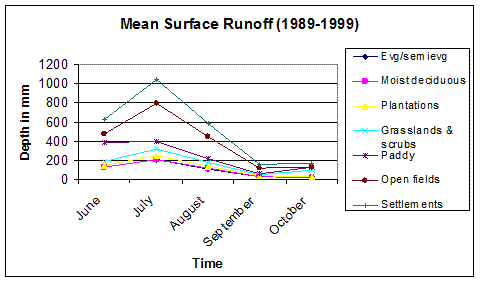
Figure 5.32 shows the variation in surface runoff generation from western sub basins to eastern sub basins portion with respect to rainfall. Table 5.21 shows the values the percentage variation of runoff w.r.t. rainfall.
Figure 5.32: Rainfall-Surface Runoff Generation (1989-1999)
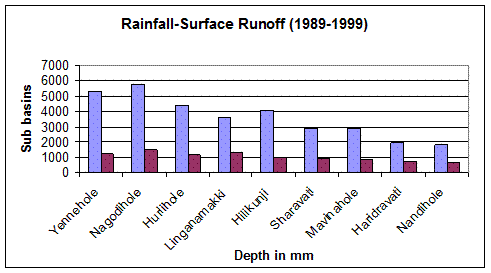
Table 5.21: Percentage of Surface Runoff w.r.t Rainfall
Sub basins |
Runoff (%) |
Yenneholé |
23.43 |
Nagodiholé |
26.06 |
Hurliholé |
26.77 |
Linganamakki |
35.52 |
Hilkunji |
24.44 |
Sharavathi |
31.2 |
Mavinaholé |
30 |
Haridravathi |
36.39 |
Nandiholé |
34.8 |
Low runoff generation in western (Yenneholé, Nagodiholé and Hurliholé) can be due to good vegetation cover and lower anthropogenic activities as compared to eastern sub basins (Mavinaholé, Haridravathi and Nandiholé). There is also high percentage of forest cover in the western clusters, which intercepts 20-30% of the rainfall before it reaches the ground. Natural forests are effective at retarding overland flow preventing flash floods downstream. Agricultural activities and open fields are higher in Haridravathi and Nandiholé resulting in higher runoff.
Sub Surface Runoff or Pipeflow
Table 5.22 gives the mean total sub-surface generation different sub basins. Pipes are abundant in the Western Ghats and are a general feature in undisturbed evergreen/semievergreen forests and moist deciduous forests. While a part of the pipe outflow is from storage build up during previous rainfall evens, some part would presumably for current rainfall also (Putty and Prasad, 2000). Pipe outflow was not significant in the forested catchments and as observed by Putty and Prasad, 2000, may be due to the high infiltration capacity of the soil that pipe outflow does not create saturation of the soil.
Table 5.22: Mean Total Sub Surface Flow Generation
Sub basins |
Mean total pipeflow (1989-1999) (mm) |
Yenneholé |
173.56 |
Nagodiholé |
193.83 |
Hurliholé |
142.51 |
Hilkunji |
135.27 |
Sharavathi |
90.57 |
Mavinaholé |
257.07 |
Upstream |
158.3 |
Here pipe flow increases from west to south of the basin. These are the areas of abundant vegetation consisting of evergreen/semievergreen and moist deciduous forests. However, Mavinaholé shows the highest total pipe flow as it has the lowest relief ratio. Table 5.23 shows the percentage of pipe flow w.r.t rainfall which is a very small component.
Table 5.23 Percentage of Pipeflow w.r.t Rainfall
Sub basins |
Pipe flow (%) |
Yenneholé |
3.27 |
Nagodiholé |
3.37 |
Hurliholé |
3.23 |
Hilkunji |
3.3 |
Sharavathi |
3.03 |
Mavinaholé |
8.85 |
5.5 Evapotranspiration
Table 5.24 shows the mean monthly transpiration for different vegetation types in the study area calculated by Turc’s equation, which makes use of albedo. Albedo is observed to increase from evergreen forests to crops with respect to openness and height of vegetation. Tall forests with close canopy have lesser albedo than tall forests with more open canopy. Grasses and crops are short vegetation resulting in higher albedo.
From the graph, it is observed that transpiration from evergreen/semievergreen forests is higher compared to other vegetations. This is attributed to the albedo. Albedo from tall forests with thick canopy is less i.e. the amount of energy reflected (a) is less due to internal reflections. Lesser albedo indicates that the energy that is absorbed by the vegetation (1-a) is high. It is the absorbed energy, which is responsible for phase change i.e. from liquid water to water vapour. Turc’s equation is radiation based and is not limited by the absence of water. Moist deciduous forests and plantations are more open, which results in higher albedo and that means lesser energy available for conversion of liquid water to water vapour. The mean annual transpiration decreases from evergreen/semievergreen forests to paddy crop.
Transpiration values peak during summer when plants use up most of the water but varies with the type of vegetation. Three factors may be playing a role in transpiration during summer i.e. a) solar energy or insolation, b) soil moisture, c) rooting depth.
During summer, there is greater energy available for plant absorption. Absorption of this energy by the leaf raises its temperature and its water vapour pressure. The result is that transpiration increases along with insolation.
Transpiration is dependent on the soil moisture. The soil moisture regime in the basin is ustic i.e it is moist for 90 or 180 days (during monsoon months) and dry during the remaining period. However, in evergreen/semievergreen forests the soil moisture is conserved due to thick leaf litter and since light penetration is very low, evaporation from the soil is also minimal. Thus, during summer, soil moisture pool under an evergreen/semievergreen forests is quite high as compared to moist deciduous or plantations, facilitating in higher transpiration.
Another factor that affects plant water uptake, in other words transpiration is the rooting depth of plant species. Calder, 2002 indicates that studies of transpiration in dry (drought) conditions show that the transpiration from forests is likely to be higher because of the generally increased rooting depth of trees as compared with shorter crops such as grass and paddy and their consequent greater access to soil water.
Evergreen, deciduous and plantation tree species mostly have taproots that are deep, but in mature evergreen trees, shallow-rooting is usually indicated by a more swollen tree base. They also have low root:shoot ratio i.e. the biomass in shoots are higher than roots. Buttressing indicates a very shallow root system and are a feature of many trees in the forests of upstream river basin. It also provides support for large trees. Since trees with buttress roots have shallow root system, it can only survive where there is sufficient soil moisture storage in the upper soil, especially during the lean season. But as the moisture regime in the basin is ustic, it can be assumed that evergreen trees with non-buttressed roots may have deeper taproots to tap moisture during summer.
Deciduous trees also have deep taproots but conserve water during summer by leaf shedding. Leaves appear in May after a bout of convective rains in April, thus moistening the soil. Certain plantation species such as Eucalyptus sp. is known to tap water deep from the soil creating severe soil moisture deficit (Scott and Lesch, 1997). Such trees are known to survive in dry areas where surface soil moisture is quite low. Grasses and crops have fibrous roots with high root:shoot ratio i.e. the biomass of roots are higher than shoots but are shallow and therefore cannot tap water deep from the soil. Grasses wither during dry season leaving the scrubs in the basin. Transpiration due to crops such as paddy is the least and zero during summer as it is grown only during rainy season. Thus, higher transpiration is observed in trees during summer than during the monsoon and winter season.
It is also observed that transpiration is small during the monsoon period. The reason maybe due to high vapour pressure gradient, which occurs when the vapour pressure of the air becomes high due to high relative humidity. As a result, little transpiration occurs. Even if the rainfall event continues over several days, transpiration cannot occur because of the high gradient.
Note: Evg/SE- evergreen/semievergreen forests; MD – moist deciduous forests
Plant- plantations; Grass- grasslands and scrubs; Agri – agricultural lands
Table 5.24: Mean Monthly Transpiration for Different Vegetation Types
|
Transpiration in mm |
|||||
Months |
Evg/SE |
MD |
Plant |
Grass |
Agri |
Total |
Jan |
54.06 |
52.01 |
51.63 |
41.5 |
- |
199.3 |
Feb |
55.5 |
53.7 |
53.05 |
42.7 |
- |
204.95 |
Mar |
61 |
58.22 |
58.21 |
46.8 |
- |
224.2 |
Apr |
61.4 |
58.8 |
58.6 |
47.1 |
- |
225.9 |
May |
60.7 |
57.6 |
59.5 |
46.5 |
- |
224.3 |
June |
41.3 |
40.8 |
40.7 |
34 |
- |
156.8 |
July |
40.2 |
39.9 |
39.6 |
33.1 |
33.19 |
185.99 |
Aug |
42.8 |
42.3 |
42.1 |
35.2 |
35.24 |
198.64 |
Sept |
49.2 |
48.5 |
48.4 |
40.3 |
38.11 |
224.51 |
Oct |
50.8 |
49.8 |
49.9 |
39.2 |
- |
189.7 |
Nov |
50.7 |
48.4 |
48.5 |
39.1 |
- |
186.7 |
Dec |
52.5 |
50 |
50.2 |
40.4 |
- |
193.1 |
Figure 5.33: Mean Monthly Transpiration for Different Vegetation Types

The decrease in mean annual transpiration for each vegetation type is as shown in Figure 5.33. Table 5.25 shows the mean annual transpiration of vegetation types in the basin.
Table 5.25: Mean Annual Transpiration for Different Vegetation Types
Vegetation type |
Mean annual transpiration (1989-1999) (mm) |
Evergreen/semievergreen forests |
620.7 |
Moist deciduous forests |
600.76 |
Plantations |
598.32 |
Grasslands and scrubs |
486.76 |
Paddy (3 months) |
106.55 |
Table 5.26 gives the monthly evaporation for bare soil, settlements and water bodies. Evaporation from open water is found lower compared to bare soil and settlements. Waterbodies have very low albedo resulting in greater absorption of energy. Large and deep water bodies such as Linganamakki reservoir also have high heat storage capacity and thermal inertia. Solar energy penetrates to greater depth in water which results in slow heating. This results in lesser evaporation. Since solar radiation can only penetrate a few centimeters of soil due to its chemical composition and the structure, the air above the soil warms up much more rapidly due to the low heat capacity of air. This results in high evaporation from soil. However, bare soil evaporation also depends on moisture content of the soil. Wetter the soil, lower the evaporation and vice versa. Bare soil evaporation during wet season is low as greater energy is required to overcome the attractive forces of water and soil particles. Table 5.27 shows the annual evaporation for each cover type.
Table 5.26: Mean Monthly Evaporation for Other Land covers
Months |
Open water (mm) |
Open fields (bare soil) (mm) / Settlements (mm) |
Total |
Jan |
38.66 |
47.14 |
85.8 |
Feb |
39.64 |
48.44 |
88.08 |
Mar |
43.96 |
52.98 |
96.94 |
Apr |
44.2 |
53.4 |
97.6 |
May |
43.77 |
52.74 |
96.51 |
June |
26.7 |
46.35 |
73.05 |
July |
26.06 |
45.12 |
73.05 |
Aug |
28.1 |
48 |
71.18 |
Sept |
34.14 |
55.23 |
89.37 |
Oct |
35.21 |
56.97 |
92.18 |
Nov |
35.58 |
44.5 |
80.08 |
Dec |
37.73 |
45.9 |
83.63 |
Figure 5.34: Mean Monthly Evaporation for Other Land covers

Table 5.27: Mean Annual Evaporation for Other Land covers
Cover type |
Mean annual evaporation (1989-1999) (mm) |
Open fields |
596.81 |
Settlements |
596.81 |
Water bodies |
436.72 |
5.6 Groundwater Recharge/Discharge
Groundwater recharge analysis results are given in Table 5.28. The rate of replenishment or recharge is dependent on the soil moisture status, which in turn is dependent on soil texture. Soil texture in the study area varies from loamy sand to clay loam. From soil studies, sand is an important constituent in the basin and is responsible for high infiltration rates. Average recharge in the basin is 30.3% of the rainfall.
Total mean monthly recharge is observed to vary from west to east with the eastern sub basins receiving the least recharge.
Table 5.28: Mean Monthly Recharge (1989-1999)
Months Sub basins |
June |
July |
August |
September |
October |
Total |
Yenneholé |
373.61 |
620.46 |
380.94 |
98.59 |
46.94 |
1513.76 |
Nagodiholé |
506.22 |
770.94 |
438.34 |
109.72 |
65.5 |
1883.3 |
Hurliholé |
329.02 |
546.28 |
280.09 |
75.23 |
58.44 |
1282.99 |
Linganamakki |
280.83 |
495.75 |
270.88 |
66.03 |
58.7 |
1164.7 |
Hilkunji |
294.71 |
503.31 |
286.14 |
73.55 |
45.44 |
1198.12 |
Sharavathi |
212.25 |
338.87 |
163.59 |
44.53 |
52.81 |
803.28 |
Mavinaholé |
178.7 |
291.96 |
144.72 |
42.68 |
65.12 |
712.04 |
Haridravati |
125.9 |
217.48 |
135.84 |
42.98 |
63.57 |
576.13 |
Nandiholé |
119.75 |
205.33 |
131.17 |
39.17 |
56.17 |
544.55 |
Upstream |
220.16 |
360.62 |
200.06 |
55.44 |
59.33 |
886.71 |
Table 5.29: Mean Monthly Recharge Under Different Land use
Months |
June |
July |
August |
Sept |
Oct |
Evergreen/semievergreen |
325.13 |
532.15 |
302.78 |
76.81 |
54.19 |
Moist deciduous forests |
248.75 |
419.05 |
213.68 |
60.71 |
59.57 |
Plantations (areca, mango) |
347.1 |
573.58 |
325.21 |
83.42 |
74.3 |
Grasslands and scrubs |
277.98 |
463.39 |
258.34 |
70.06 |
56.56 |
Paddy |
175.68 |
394.35 |
203.52 |
51.75 |
57.46 |
Open fields |
201.37 |
337.17 |
190.28 |
50.72 |
53.55 |
Settlements |
98.4 |
163.16 |
91.91 |
24.91 |
27.09 |
Mean monthly recharge under different land use is shown in Table 5.29. From Figure 5.35, it is clearly observed that recharge under vegetation is higher as compared to other land cover types. Among different vegetation types, recharge under plantation was slightly higher as compared to natural forests (evergreen/semievergreen forests and moist deciduous forests). Plantation trees include areca and mango. Areca plantations are a common feature in the river basin and are extensively grown in river valleys. Lesser recharge in natural forests may be due interception (20-30%) and diversion of infiltration water by sub surface flow (10-30%). Sub surface flow phenomenon is not observed under plantations. Paddy, open fields and settlements show the least recharge. It is observed from the graph that recharge peaks during July and tapers off with decreasing rainfall.
Figure 5.35: Mean Monthly Recharge Under Different Land use

Total recharge in each sub basin was compared with total rainfall and total surface runoff to determine any variation. Table 5.30 gives the variation in each sub basin.
Table 5.30: Rainfall-Runoff-Recharge Variation
Sub basin |
Rainfall (mm) |
Recharge (mm) |
Runoff (mm) |
Yenneholé |
5300.3 |
1513.76 |
1241.96 |
Nagodiholé |
5740.1 |
1883.3 |
1496.39 |
Hurliholé |
4410.1 |
1282.99 |
1180.72 |
Linganamakki |
3623.8 |
1164.7 |
1287.72 |
Hilkunji |
4091 |
1198.12 |
1000.1 |
Sharavathi |
2930.3 |
803.28 |
914.29 |
Mavinaholé |
2904.7 |
712.04 |
871.5 |
Haridravati |
1929.6 |
576.13 |
702.28 |
Nandiholé |
1792.7 |
544.55 |
623.9 |
Figure 5.36 clearly shows the variation of recharge and runoff w.r.t rainfall. It is interesting to note that sub basins with larger vegetation covers have higher recharge. Vegetation such as forests not only provide shade to the ground that prevent soil water from evaporating, it provides organic matter to the soil in the form of forest litter sand, other microorganisms etc. Decomposition of this layer results in an organic rich top layer called humus, which enhances infiltration rates and replenishes the aquifers. Due to higher concentration of anthropogenic activities in the eastern basins, recharge is considerably reduced as forests are cleared for agricultural and other purposes. Recharge is an extremely important component as it is responsible for providing flow in rivers during dry seasons from the aquifers.
Figure 5.36: Rainfall-Runoff-Recharge (1989-1999)
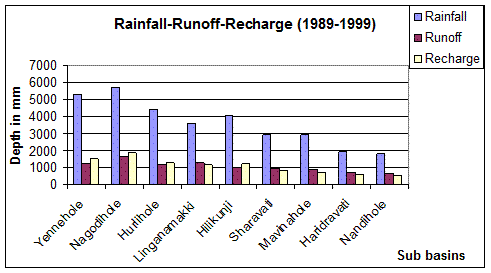
Groundwater Discharge/Baseflow Analysis
The determination of groundwater volumes and flow rates requires a thorough knowledge of the geology of the groundwater basin (Viessman, 1989). The geologic structure of a groundwater basin governs the occurrence and movement of the groundwater beneath it. Base flow contribution to stream flow varies widely according to the geologic nature of the aquifer.
The two major rock types occurring in the basin are gneisses /granites and greywackes. Gneisses and granites have the lowest specific yield (3%) and occurs in the eastern portion of the study area such as Mavinaholé, Haridravati and Nandiholé. Hence, streams here are ephemeral indicating baseflow only during monsoon season. Western sub basins have perennial streams, which is an indication of the rock types present in the area. The region consists of greywackes, which has higher specific yield of 27%. Discharge for each sub basin is given in Table 5.31.
Table 5.31: Mean Total Discharge (1989-1999)
Sub basins |
Mean total discharge |
Yenneholé |
225.98 |
Nagodiholé |
463.95 |
Hurliholé |
192.44 |
Linganamakki |
174.7 |
Hilkunji |
179.71 |
Sharavathi |
120.49 |
Mavinaholé |
21.36 |
Haridravati |
17.28 |
Nandiholé |
16.33 |
Upstream |
92.05 |
Another important reason for better discharge in western sub basins is the good vegetation cover. Natural forests retard much of the overland flow facilitating in enhanced infiltration and thus recharge. In other words, regardless of the geology the amount of water entering an aquifer is dependent first on the vegetation and soil present in the area. Forestlands cleared for agriculture or other purposes increases overland flow thus decreasing recharge and subsequent discharge into the streams.
Well Behavioral Analysis
Water table levels of ten wells were available to observe groundwater fluctuations and behavior in the basin. These wells were mainly located in eastern portion and southern portion of the study area. Well data for western sub basins were not available. Table 5.32 gives the long term trend and amplitude in each well.
Table 5.32: Long Term Trend and Amplitude in Selected Wells in Upstream
Well Nos. |
Amplitude |
Depth to Water Table |
170504 |
Strong dampening |
Increasing |
170511 |
Slight dampening |
Increasing |
170510 |
Strong dampening |
Increasing |
170502 |
Strong dampening |
Increasing |
170410 |
Strong dampening |
Decreasing |
170402 |
Strong dampening |
Decreasing |
170406 |
Slight dampening |
Increasing |
170401 |
Strong dampening |
Increasing |
170404 |
Strong dampening |
Decreasing |
170903 |
Strong dampening |
Increasing |
It is interesting to note that wells showing increase in water depth had dampening effect with some showing strong effects. Dampening indicates reduction in amplitude, which may be due to groundwater overexploitation occurring during the rainy season (June-August) with the result that well levels are unable to rise even during heavy rainfall. Other reasons may include groundwater irrigation and the type of irrigation practiced or the downstream overexploitation of ground water, which has affected well levels upstream. The dampening effect is seen beginning from 1994-1999 in all wells.
Well no. 170404 showed decrease in the depth to water table with strong dampening. The reason may be due to the fact that water logging by damming Linganamakki reservoir would have increased recharge or downstream pumping may have changed the geometry of the basin. Also, as it is along the ridgeline there is quicker drainage of water, which would have increased the water levels. Well nos 170410 and 170402 are located in Haridravati and Nandiholé sub basin respectively. Both these wells showed decrease in depth to water table i.e. the water table must be rising in these regions but shows strong dampening effect due to over extraction of groundwater.
Figure 5.37 depict the water table depths in well. Negative values actually indicate the water levels below ground. Zero is considered the ground level or reference level.
Figure 5.37 Water Table Depths (bgl) in Selected Wells Upstream (1989-1999)
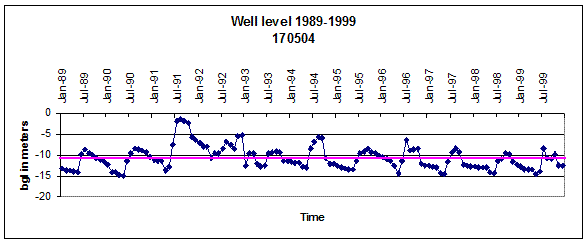


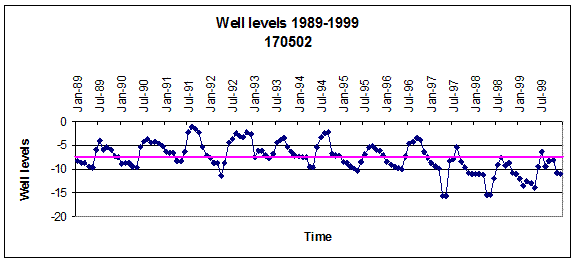


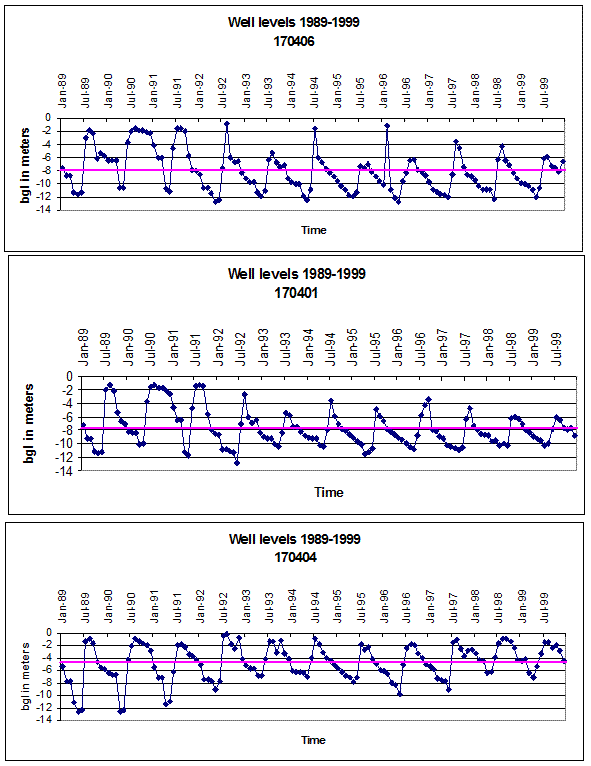
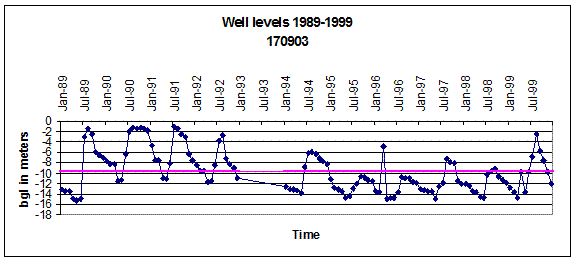
Mean monthly water table levels showed similar seasonal fluctuations i.e. water table rises during monsoon season and thereafter decreases. Water table is almost steady during August to September and decreases with the maximum decline in the month of May. Decrease in water levels is partly due to natural discharge or baseflow and partly due to artificial extraction of groundwater. Streams located south of the basin receive substantial baseflow during non-monsoon season. The amount of baseflow decreases from south to east such as Nandiholé and Haridravati. It is observed that wells in the region have reported decrease in water levels and as such fail to provide baseflow during the lean season. Streams in these sub basins are ephemeral.
Variation of water table levels is also seen within a sub basin. For example, well no. 170502 located in Nandiholé sub basin showed increase in water table levels whereas well no. 170504 located in the same sub basin showed decrease in water table levels. Well no. 170903 also showed decrease in well levels even though it is located near Hilkunji, which has higher rainfall than Nandiholé and Haridravati. Natural and artificial factors such as soil texture, the hydraulic characteristics such as specific yield of aquifers, the amount of recharge, distribution of vegetation types, topography and climate and artificial factors may be showing a combined effect in influencing well levels in the region.
Table 5.33 gives the mean monthly water table levels in selected well. Figure 5.38 gives the graphical representation of well levels. It is seen that well levels increases during the monsoon season and thereafter decreases.
Table 5.33: Mean Monthly Water Table Levels in Selected Wells (1989-1999)
|
170504 |
170511 |
170510 |
170502 |
170410 |
170402 |
170406 |
170401 |
170404 |
170903 |
Jan |
11.71 |
7.33 |
8.63 |
1.6 |
8.94 |
4.33 |
8.55 |
8.35 |
5.33 |
10.95 |
Feb |
11.96 |
7.76 |
8.94 |
1.78 |
9.49 |
4.96 |
8.53 |
9.23 |
6.2 |
11.75 |
Mar |
12.03 |
8.05 |
9.03 |
1.88 |
9.72 |
5.12 |
9.58 |
9.35 |
6.73 |
11.15 |
Apr |
13.14 |
9.14 |
10.88 |
2.22 |
11.31 |
5.93 |
11.29 |
10.64 |
8.45 |
12.79 |
May |
13.46 |
9.25 |
10.89 |
2.31 |
11.8 |
6.17 |
11.76 |
10.74 |
8.73 |
13.57 |
June |
11.06 |
7.21 |
7.3 |
0.87 |
10.42 |
3.8 |
9.96 |
8.82 |
6.1 |
11.29 |
Jul |
8.16 |
4.82 |
5.19 |
0.6 |
5.95 |
1.47 |
5.29 |
4.58 |
1.55 |
7.16 |
Aug |
8.1 |
4.3 |
4.73 |
0.57 |
4.32 |
1.36 |
4.08 |
4.18 |
1.36 |
5.5 |
Sept |
8.16 |
4.62 |
5.02 |
0.56 |
4.75 |
1.99 |
5.19 |
5.24 |
2.13 |
6.43 |
Oct |
9.08 |
5.17 |
5.87 |
0.89 |
6.14 |
2.71 |
6.69 |
6.7 |
2.89 |
7.35 |
Nov |
10.29 |
6.2 |
7.14 |
1.14 |
6.87 |
3.27 |
7.2 |
7.25 |
3.32 |
8.66 |
Dec |
10.66 |
6.56 |
7.73 |
1.37 |
7.49 |
3.79 |
7.73 |
7.93 |
4.43 |
9.47 |
Figure 5.38: Mean Monthly Water Table Levels in Selected Wells (1989-1999)
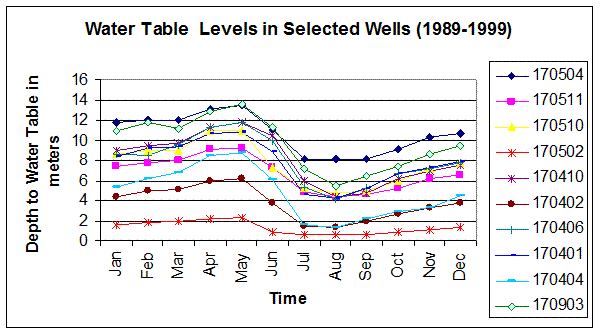
5.7 Water Budget
Water budgeting was done sub-basinwise in the river basin. For example, water budget for Yenneholé was estimated for each month in Table 5.34. Change in storage in Yenneholé sub basin is given in Figure 5.39.
Table 5.34: Water Budget -Yenneholé
MEAN MONTHLY WATER BUDGET ( x 106 m3) – YENNEHOLÉ (1989-1999) |
|||||||||
Month |
R |
I |
T |
E |
SR |
P |
GR |
GD |
Change in storage |
January |
|
|
6.93 |
2.06 |
|
|
|
0.0095 |
-11.03 |
February |
|
|
7.12 |
2.07 |
|
|
|
0.002 |
-11.36 |
March |
|
|
7.82 |
2.23 |
|
|
|
0.0004 |
-12.39 |
April |
|
|
7.88 |
2.29 |
|
|
|
0.0001 |
-12.6 |
May |
|
|
7.87 |
2.28 |
|
|
|
|
-12.56 |
June |
243.62 |
47.09 |
5.42 |
2.06 |
62.37 |
|
69.38 |
|
55.09 |
July |
395.86 |
76.87 |
5.40 |
1.87 |
100.32 |
|
115.12 |
|
94.28 |
August |
248.56 |
48.52 |
5.74 |
1.96 |
62.26 |
|
70.74 |
20.93 |
80.27 |
September |
64.14 |
13.12 |
6.59 |
2.22 |
16.06 |
0.674 |
18.30 |
4.26 |
26.44 |
October |
31.41 |
6.35 |
6.60 |
2.36 |
8.96 |
0.0044 |
8.23 |
0.92 |
-0.01 |
November |
|
|
6.52 |
1.97 |
|
|
|
0.29 |
-9.65 |
December |
|
|
6.75 |
1.95 |
|
|
|
0.0442 |
-10.47 |
Figure 5.39: Water Budget -Yenneholé
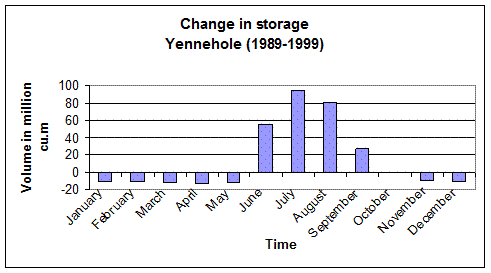
Similar analyses were done for the other sub basins (except Linganamakki). Monthly change in storage for each sub basin is graphically represented as follows.
Figure 5.40: Water Budget -Nagodiholé
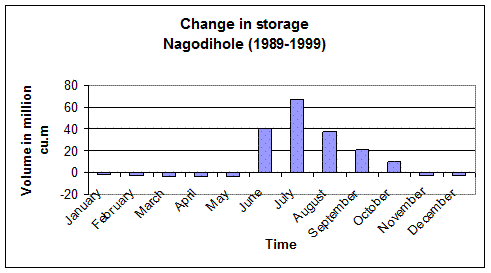
Figure 5.41: Water Budget -Hurliholé


Figure 5.42 Water Budget - Hilkunji

Figure 5.43: Water Budget - Sharavathi
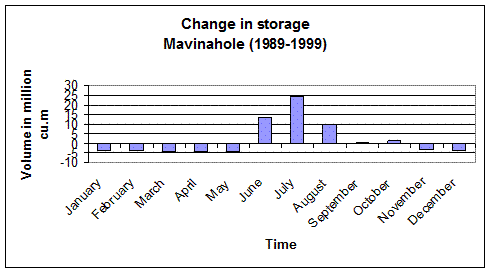
Figure 5.44: Water Budget - Mavinaholé

Figure 5.45: Water Budget - Haridravathi
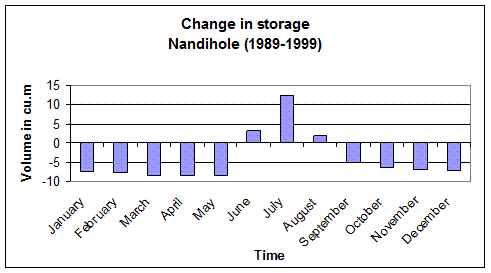
Figure 5.46: Water Budget - Nandiholé

Figure 5.47: Water Budget – Upstream
The total change in storage for each sub basin is given in Table 5.35. Storage consists of the water contained in soil and the underlying rock. Higher storage in western sub basins are responsible for the lush vegetation present in these areas. During summer, the plants can extract sufficient moisture from the soil for its physiological processes.
Table 5.35: Total Storage in Sub Basins
Sub basins |
Mean Total Storage (x 106 M cu.m) (June-Oct) |
Yenneholé |
233.09 |
Nagodiholé |
171.56 |
Hurliholé |
86.80 |
Linganamakki |
834.69 |
Hilkunji |
68.55 |
Sharavathi |
70.54 |
Mavinaholé |
48.03 |
Haridravathi |
51.21 |
Nandiholé |
17.6 |
Mean annual volumes of hydrological components in each sub basin are given in Table 5.36.
Table 5.36: Mean Annual Volumes of Hydrological Component ( x 106 m3) (1989-1999)
Sub basins |
R |
I |
T |
E |
SR |
P |
GR |
GD |
Yenneholé |
983.6 |
191.96 |
80.7 |
25.37 |
281.78 |
0.67 |
286.79 |
26.47 |
Nagodiholé |
374.68 |
86.63 |
32.22 |
6.7 |
88.91 |
0.79 |
115.75 |
16.98 |
Hurliholé |
413.69 |
85.32 |
42.13 |
12.74 |
111.88 |
0.62 |
200.72 |
11.55 |
Linganamakki |
2915.53 |
379.06 |
265.12 |
228.73 |
815.2 |
- |
749.01 |
78.05 |
Hilkunji |
337.85 |
77.31 |
39.45 |
7.72 |
83.03 |
0.8 |
99.38 |
9.23 |
Sharavathi |
358.68 |
61.53 |
50.4 |
17.89 |
119.0 |
0.26 |
105.46 |
9.46 |
Mavinaholé |
254.41 |
42.71 |
33.16 |
13.58 |
78.81 |
0.3 |
64.97 |
1.17 |
Haridravathi |
555.82 |
77.56 |
90.3 |
51.25 |
188.13 |
- |
184.79 |
3.25 |
Nandiholé |
31.08 |
49.84 |
61.24 |
29.67 |
125.3 |
- |
97.37 |
1.86 |
Table 5.37: Mean Monthly Stream flow Contribution in Sub Basins
(x 106 m3) (1989-1999)
Sub basin |
Yenne |
Nagod |
Hurli |
Lingan |
Hili |
Shara |
Mavin |
Hari |
Nandi |
Jan |
0.0095 |
0.029 |
0.008 |
0.039 |
0.002 |
0.002 |
0.002 |
0.002 |
0.002 |
Feb |
0.0021 |
0.006 |
0.001 |
0.008 |
0.0006 |
0.0005 |
0.0004 |
0.0003 |
0.0002 |
Mar |
0.0004 |
0.001 |
0.0004 |
0.001 |
0.00018 |
0.00016 |
0.00015 |
0.0001 |
0.0001 |
Apr |
0.0001 |
0.0002 |
0.0002 |
0.0004 |
- |
- |
- |
- |
- |
May |
- |
0.0001 |
- |
0.0002 |
- |
- |
- |
- |
- |
Jun |
69.38 |
35.34 |
28.87 |
204.14 |
21.25 |
33.85 |
19.63 |
35.47 |
28.87 |
Jul |
115.11 |
20.11 |
47.16 |
333.96 |
33.74 |
47.07 |
32.01 |
70.35 |
47.16 |
Aug |
91.67 |
19.84 |
33.36 |
237.84 |
27.24 |
30.3 |
15.85 |
44.01 |
33.63 |
Sept |
23.25 |
19.29 |
9.03 |
62.97 |
6.44 |
7.79 |
5.96 |
16.63 |
9.03 |
Oct |
9.16 |
2.75 |
5.49 |
53.21 |
4.29 |
9.62 |
6.77 |
24.77 |
5.49 |
Nov |
0.29 |
0.59 |
0.09 |
0.87 |
0.09 |
0.065 |
0.04 |
0.12 |
0.09 |
Dec |
0.044 |
0.13 |
0.01 |
0.19 |
0.01 |
0.01 |
0.009 |
0.019 |
0.01 |
The mean monthly stream flow contribution for all sub basins is given in Table 5.37. It is the sum of surface runoff, sub surface runoff (pipeflow) and groundwater discharge. Natural and artificial forces operating over a watershed or a basin ultimately impacts its stream flow regime. Perenniality of streams is dependent on factors such as geology, type and distribution of vegetation, soil, climate and topography. Western clusters enjoys the benefit of good rainfall, vegetation and geology to give rise to stream flow even during the lean season. A contrast is seen on the eastern side as volume of stream progressively decreases from Hilkunji to Nandiholé sub basins. Modification of land by agriculture and other uses, unfavourable geology, clearcutting of natural forests and poor rainfall have resulted in decline in baseflow during the non-monsoon months and significant decrease during summer (Mar-May).
The evergreen forests have high humidity thereby are the major driving forces in determining the amount of rainfall in these regions. Thus in the upstream, heavy rainfall occurs along Nagodi, Kogar and Aralagodu raingauge stations. Forest cover in these regions is also high (land cover analysis, land use analysis) indicating the close relationships between rainfall in Western Ghats regions with the type (evergreen, semi-evergreen) and spatial extent of vegetation cover (Table 5.38). Within the catchment area of Linganamakki, the areas surrounded by rich vegetation like Nagara, Karimane, Byakodu receive high rainfall compared to fragmented, poorly vegetated eastern regions like Ulluru, Anandapura and Ripponpet.
It is found that western side sub-basins (Nagodihole, Hurulihole, Yennehole) have rain fall ranges from 4500-6500 mm and their stream flow is quite high having grade of A (perennial streams). Sub-basinwise stream flow is given in Table 5.39. South east region (Sharavathi, Hilkunji) has rain fall of around 5000mm with stream flow moderate to high having grading of B-C (stream flow for 6-9 months). Finally sub-basins of eastern side (Nandihole, Haridravathi and Mavinahole) have rain fall of 1400-3000 mm which is very less and their stream flow is also quite low, graded C-D (4-6 months: mostly during monsoon).

6.0 Conclusions
This study explored and quantified the altered hydrological parameters due to large scale land use and land cover changes. In this regard, satellite data has offered excellent inputs to monitor dynamic changes through repetitive, synoptic and accurate information of the changes in a river basin. It also provided a means of observing hydrological state variables over large areas, which was useful in parameter estimation of hydrologic models. GIS offered means for merging various spatial themes (data layers) that was useful in interpretation, analysis and change detection of spatial structures and objects. Studies reveal the linkages among variables such as land use, hydrology and ecology. Following are the conclusions drawn from the hydrological studies of upstream, river basin.
Rainfall analysis based on one hundred years data for Sagara and Hosanagara show reduction of –3.55% and 5% respectively in the Sharavathi upstream river basin Regression analysis was carried out for each rain gauge station considering rainfall as dependent variable and latitude, longitude, altitude and land cover as independent variables. Regression analysis showed rainfall having significant relationship (5% level of significance) between land cover, latitude, longitude, and altitude.
Interception was comparatively high in evergreen/semievergreen forests due to thicker and multilayered canopies. It was followed by moist deciduous forests, plantations, scrub savanna and paddy. Interception was the highest during peak rainfall months and showed least values for shorter crops.
Transpiration also decreased from evergreen/semi-evergreen forests to paddy due to lower albedo in the former. Lower albedo corresponds to higher latent energy, which converts liquid water to water vapour. Transpiration peaks during summer and is the lowest during the monsoon season. Low transpiration during wet months is because most of the energy available for evaporation is consumed by the interception process, which precedes transpiration and because solar radiation is inhibited by clouds in the wet months (Shuttleworth, 1993).
Catchments with good forest (evergreen/semi-evergreen and moist deciduous forests) cover showed reduced runoff as compared to catchments with poor forest covers. The results are similar to conclusions drawn by Bosch and Hewlett, 1982 from various catchment experiments that forested areas have reduced runoff as compared with those under shorter vegetation. Runoff and thus erosion from plantation forests was higher from that of natural forests. Erosion rates in undisturbed natural forest could be considered to represent a natural baseline or background erosion rates against which the erosion rates from all other land uses.
Sub-surface flow caused by pipes in the Western Ghats appears at valley bottoms of forested slopes. The macropore flow collects in the pipes and flows through them into the stream. Recharge in the sub basins varied with respect to vegetal cover and soil texture. Higher recharge was observed in sub basins with good forest cover.
Sub basins with good forest cover showed good amount of dry season flow for all 12 months with the flow decreasing as we move towards east. Decrease of low flows in eastern sub basins can be partly attributed to eucalyptus plantations. Eucalyptus trees have deep roots that tap water deep in the soil mantle creating severe soil moisture deficits. It may take many years of rainfall before field capacity conditions can be established and recharge of the groundwater aquifer and perennial flows can take place. Another reason is the low specific yield of the underlying rock.
This highlights the impacts of tropical forests on dry season flows as the infiltration properties of the forest are critical on the available water partitioned between runoff and recharge (leading to increased dry season flows).
In short, sub basins with good vegetation cover i.e. natural forests and low anthropogenic activities especially in the western sub basins had high interception, transpiration, recharge and discharge and low surface runoff. On the other hand, eastern sub basins with less natural forest cover had low interception, transpiration, recharge and discharge and high surface runoff.
The anthropogenic influences on the land cover are related to the land use for agriculture, plantation forestry and urbanisation. It was obvious from the present study that land use has an implication on the hydrological components operating in the river basin. However, further research may be necessary to understand the scale of study, low flow mechanism in rivers, sub surface flow distribution under forests in Western Ghats etc.
Some studies that need to be considered in the future analysis are discussed below.
- The scale of study is important as macro level understanding of the hydrology of a river basin may not be enough to capture the dynamics as some changes are relevant only at micro scale. For example, clearing a few hectares of forest may not influence the regional or global hydrological cycle but it can have implications on the local water cycle. Impact on the local water cycle can affect the micro ecosystem, which may harbour flora and fauna that are adapted to that type of an environment. A water balance study should thus link the ecology and hydrology of a river basin so as to understand the complexities of a region.
- Interception analysis in the present study takes into account only the storage capacity and its associated evaporative fraction, intensity of rainfall and seasonality of vegetation. Interception is also dependent on leaf thickness, leaf and stem roughness and leaf orientation, which varies with species. Components such as stemflow and throughfall have not been considered and have to be included in future analysis.
- Field studies of soil are required to determine the soil infiltration rates. In the present study, infiltration is the difference of net rainfall and surface runoff and the actual values may differ. Studies have proved that infiltration under forested areas in Western Ghats is high.
- Sub surface flow distribution through pipes in Western Ghats has only been studied in the past few years. Pipeflow have been observed to contribute to flow in streams and in Western Ghats, many dug wells are known to derive their water from large diameter pipes. In regions where Hortonian flow cannot occur, it is observed that pipe overland flow which is new mechanism of runoff generation occurs. This has not been quantified in the studies and needs to be included in future analysis. Studies are also needed to understand the extent and distribution of pipes under forested slopes.
- Low flow contribution to stream flow in the study area takes into consideration only the natural factors and not artificial factors such as pumping. The effects of groundwater pumping near the head of a perennial river may result in groundwater table depletion through tapping of recharge water. This can result in substantial environmental degradation of the river habitats, loss of naturally sustained fisheries, reduction in the general amenity value of the river. Monitoring of wells in the western sub basins are needed to obtain a more realistic picture in the analysis.
- The use of remote sensing data should be maximized in watershed studies. It is particularly useful to study the spatial and temporal dynamics in tropical forested watershed as field studies may prove to be difficult depending on the region. However, training site strategies and choice of classification methods have to be considered in order to classify the vegetation in these regions accurately due to its diversity.
7.0 REFERENCES
Adler, R.F. and Negri, A.J., 1988. A satellite infrared technique to estimate tropical convective and stratiform rainfall. J.Appl. Met, 27, 30-51.
Adler, R.F., Huffman, G.J. and Keehn, P.R., 1994. Global tropical rain estimates from microwave adjusted geosynchronous IR data. Remote Sens. Rev. 11, 125-152.
Arkin, P.A. and Meisner, B.N., 1987. Spatial and annual variation in the diurnal cycle of large scale tropical convective cloudiness and precipitation. Mon. Weath. Rev. 115, 1009-1032.
Asdak, C, Jarvis P.G., van Gardingen P. and Frazer, A., 1998. Rainfall interception loss in unlogged and logged forest areas of Central Kalimantan. Indonesia, Journal of Hydrology, 206, 237-244.
Aston, A.R., 1979. Rainfall interception by eight small trees. J. Hydrol. 42, 383–396.
Ball, J.B. 2001. Forest Resources and Types, In The Forest Handbook, An overview of forest science, Evans, J (Ed), vol.1. pp 3-22.
Barnes, B.S., 1939. The structure of discharge recession curves. Trans. Amer. Geophysical Union, 20: 721-725.
Blackie, J.R., 1979a. The water balance of the Kericho catchments. E. Afr. Agric. For. J. 43, 55–84.
Blackie, J.R., 1979b. The water balance of the Kimakia catchments. E. Afr. Agric. For. J. 43, 155–174.
Brutsaert, W. and Sugita, M., 1992. A bulk similarity approach in the atmospheric boundary layer using radiometric skin temperature to determine regional fluxes. Boundary-Layer Meteor. 55, 1-23.
Brooks, J.R. Meinzer, F.C. Coulombe, R.and Gregg, J., 2002. Hydraulic redistribution of soil water during summer drought in two contrasting pacific northwest coniferous forests. Tree Physiology 22, 1107–1117.
Bruijnzeel, L.A. and Wiersum, K.F., 1987. Rainfall interception by a young Acacia auriculiformis A.Cunn. plantation forest in West Java, Indonesia: application of Gash’s analytical model. Hydrological Processes 1, 309-319.
Bruijnzeel, L.A. and Wiersum, K.F., 1987. Rainfall interception by a young Acacia auriculoformis A.Cunn. plantation forest in West Java, Indonesia: application of Gash’s analytical model. Hydrological Processes 1, 309-319.
Bruijnzeel, L.A., 1990. Hydrology of Moist Tropical Forest and Effects of Conversion: A State of Knowledge Review. UNESCO, Paris, and Vrije Universiteit, Amsterdam.
Bruijnzeel, L.A., 2001. Hydrology, In The Forests Handbook vol.1. An overview of forest science, Evans, J (Ed) pp 23-64, vol. 1.
Bruijnzeel, L.A., 2004. Hydrological functions of tropical forests: not seeing the soil for the trees. Agriculture, Ecosystems and Environment, pp 1-44.
Burgess, S. S. O., M. A. Adams, N. C. Turner, D. A. White, and C. K. Ong., 2001. Tree roots: conduits for deep recharge of soil water. Oecologia 126: 158–165.
Burgess, S.S.O., M.A. Adams, N.C. Turner and C.K. Ong., 1998. The redistribution of soil water by tree root systems. Oecologia 115: 306–311.
Calder I.R., 1977. A model of transpiration and interception loss from a Spruce forest in Plynlimon, Central Wales. J. Hydrol. 33, 247-265.
Calder, I.R., 2002.Forests and Hydrological Services: Reconciling public and science perceptions, Land use and Water Resources Research, 2, pp 2.1-2.12.
Calder, I.R. and Newson, M.D., 1979. Land use and upland water resources in Britain-a strategic look, Water Reourc. Bull. Vol. 16, pp 1628-1639.
Camargo, A.P., Marin, F.R., Sentelhas, P.C., Picini, A.G., 1999. Adjust of the Thornthwaite’s method to estimate the potential evapotranspiration for arid and superhumid climates, based on daily temperature amplitude. Rev. Bras. Agrometeorol. 7 (2), 251–257 (in Portuguese with English summary).
Camillo, P.J., Gurney, R.J. and Schmugge, T.J., 1983. A soil and atmospheric boundary layer model for evapotranspiration and soil moisture studies. Wat. Resour.Res. 19, 371-380.
Canadell, J., Jackson, R.B., Ehleringer, J.R., Mooney, H.A., Sala, O.E. & Schulze, E.D. (1996) Maximum rooting depth of vegetation types at the global scale. Oecologia, 108, 583– 595.
Carlston, C.W., 1963. Drainage density and stream flow. US Geological Survey Professional Paper 422C, Denver.
Chahine, M. T, 1992. The hydrological cycle and its influence on climate. Nature, 359, 373–380.
Champion, H.G. and Trevor, G., 1938. Manual of Indian Silviculture. Humphrey Milford Oxford University Press.
Chang, F.J. and Chen, Y.C., 2001. A counter propagation fuzzy-neural network modeling approach to real time stream flow prediction. J. Hydrol. 245, 153–164.
Charney, J. G., W. J. Quirk, S. H. Chow, and J. Kornfield., 1977. A comparative study of the effect of albedo change on drought in semi-arid regions. J. Atmos. Sci, 34: 1366-1385.
Chaulya, S.K., Singh, R.S., Chakraborty, M.K. and Srivastava, B.K., 2000. Quantification of stability improvement of a dump through biological reclamation. Geotechnical and Geological Engineering, vol. 18, no. 3, pp. 193-207(15).
Cienciala, E., Kucera, J., Malmer, A., 2000. Tree sap flow and stand transpiration of two Acacia mangium plantations in Sabah. Borneo. J. Hydrol. 236, 109–120.
Collier, C.G., 2000. Precipitation, in Remote Sensing in Hydrology and Water Management. Schultz and Engman (Eds), Springer Verlag, Germany.
Crockford, R.H. and D.P. Richardson., 1990b. Partitioning of rainfall in eucalyptus forest and pine plantation in southeastern Australia II. Stemflow and factors affecting in a dry sclerophyll eucalypt forest and a pinus radiata plantation. Hydrol. Process. 4: 145-155.
Crockford, R.H. and D.P. Richardson., 2000. Partitioning of rainfall into throughfall, stemflow, and interception: effect of forest type, ground cover and climate. Hydrol. Process. 14: 2903–2920.
D’Agnese F, Faunt, C.C. and Turner, A.K., 1996. Using remote sensing and GIS techniques to estimate discharge and recharge fluxes for the Death Valley regional groundwater flow system. U.S.A., IAHS Publ. No. 235.
Davie,T., 2003. Fundamentals of Hydrology. Routledge Fundamentals of Physical Geography Series, Routledge, London.
Dickinson, R. E., 1980. Effects of tropical deforestation on climate. In Blowing in the wind: Deforestation and long-range implications. pp. 411-441. Studies in Third World Societies, no. 14, College of William and Mary, Dept. of Anthrop., Williamsburg, Va., USA.
Doneaud, A.A., Niscov, S.I., Priegrutz, D.L. and Smith, P.L., 1984. The area-time integral as an indicator for convective rain volumes. J.Clim.App.Met, 23, 555-561.
Douglas I. 1994., Human Settlements in Changes in Land use and Land cover: A global perspective. Meyer W and Turner BL II (Eds)., pp 149-169.
Falkenmark, M., 2003. Water cycle and people: water for feeding humanity. Land Use and Water Resources Research (3) 1. [online] URL: http://www.luwrr.com/issues/vol3.html.
FAO, 1993. The challenge of sustainable forest management: What future for the world’s forests, FAO, Rome.
FAO., 2001. Global Forest Resources Assessment 2000. Food and Agriculture Organization of the United Nations, Rome, 2001.
Gadgil, M., and Meher-Homji, V.M., 1990. Ecological diversity, in J.C. Daniel and J.S.Serrao (eds), Conservation in Developing Countries: Problems and Prospects, Proceeding of the Centenary Seminar of the Bombay Natural History Society, Bombay Natural History Society and Oxford University Press, Bombay, pp. 175‑198.
Gash J.H.C., Wright, I.R. and Lloyd, C.R., 1980. Comparative estimates of interception loss from three coniferous forests in Great Britain. J Hydrol. 48: 89±105.
Gash, J.H.C., 1979 An analytical model of rainfall interception by forests. Quart. J. R. Met. Soc. 105, 43-55.
Gregory, K. J. and Gardiner, V., 1975. Drainage density and climate. Zeitschrift für Geomorphologie 19. Berlin.
Grody, N.C., 1991. Classification of snow cover and precipitation using Special Sensor Microwave Imager. J. Geophys. Res. 96, 7423-7435.
Groundwater Resource Estimation Methodology, 1997. Report of the Groundwater Resource Estimation Committee, Ministry of Water Resources, Government of India, New Delhi, June 1997.
Hall, F.G., Huemmerich, K.F., Goetz, S.N., Sellers, P.J. and Nickerson, J.E., 1992. Satellite remote sensing of surface energy balance: success, failures and unresolved issues in FIFE. J.Geophys.Res. 97 (D17), 19061-19090.
Hewlett, J.D. and Hibbert,A.R., 1967. Factors affecting the response of small watersheds to precipitation in humid area. In W.E. Sopper and H.W. Lull (eds) Forest hydrology. Pergamon, New York, pp275-290.
Hogg, W.D., 1990. Comparison of some VIS/IR rainfall estimation techniques. Preprint vol. AMS 5th Conf. Satellite Meteorology and Oceanography, London,UK, 287-291.
Homes, R.M., 1961. Discussion of a comparison of computed and measured soil moisture under snap beans. J. Geophys. Res., vol 66, pp 3620-3622).
Hope R, Jewitt G, Gowing, J. and Garratt, J., 2003. Linking the hydrological cycle and rural livelihoods: A case study in the Luvuvhu catchment, South Africa. WaterNet/Warfsa Symposium: Water, Science, Technology & Policy Convergence and Action by All, 15-17 October 2003.
Horton, R., 1945. Erosional development of streams and their drainage basin: hydrophysical approach to quantitative morphology. Geological Society of America Bulletin 56, 275–370.
Horton, R.E., 1919. Rainfall interception. Mon. Wea. Rev. 47, 603-623.
Howell, T.A. and McCormick, R.L. and Phene C.J., 1985. Design and installation of large weighing Lysimeters. Trans. Am. Soc. Agric. Eng. 28, 106-112, 117.
Jackson, R.D., Reginato, R.J. and Idso, S.B., 1977. Wheat canopy temperature: a practical tool for evaluating water requirements. Water Resource Res. 13, 651–672.
Jackson, T. J., R. M. Ragan, and R. P. Shubinkski., 1976. Flood Frequency Studies on Ungaged Urban Watersheds using Remotely Sensed Data. Proc. Natl. Symp. On Urban Hydrology, Hydraulics and Sediment Control, University of Kentucky, Lexington, KY, pp. 31-39.
Karnataka State Gazetter, 1975. Shimoga District. Govt. of Karnataka.
Kramer, P.J., 1983. Water Relations of Plants. Academic Press, New York.
Kummerow, C.D. and Giglio, L., 1994a. A passive microwave technique for estimating rainfall and vertical structure information from space. Part I Algorithm description, J.App. Met. 33, 3-18.
Kummerow, C.D. and Giglio, L., 1994b A passive microwave technique for estimating rainfall and vertical structure information from space. Part II, Application to SSM/I data, J. Appl. Met. 33, 3-18.
Kustas, W.P., Moran, M.S. and Norman, J.M., 2003. Evaluating the spatial distribution of evaporation, 26, 461-492 in Handbook of Weather, Climate and Water, Atmospheric Chemistry, Hydrology and Societal Impacts. Potter, T.D. and Colman, B.R. (Eds), 417-429.
Lambin, Helmut, J. Geist and Erika Lepers., 2003. Dynamics of land use and landcover change in tropical regions. Annu. Rev. Environ. Resour, 28:205-241.
Landsberg, J.J. and Gower, S.T., 1997. Application of Physiologic Ecology to Forest Management. Academic Press, California.
Larcher, W., 2003. Physiological Plant Ecology: Ecophysiology and Physiology of Functional Groups. 4th Springer Verlag, Berlin.
Lillesand, T.M. and Kiefer, R.W., 2002. Remote Sensing and Image Interpretation, John Wiley & Sons, Inc.
Lloyd, C.R. and Marques, Adeo., 1988. The measurement and modeling of rainfall interception by Amazonian rainforest. Agricultural and Forest Meteorology, 343: 277-294.
Maillet, E., 1905. Essai d’hydraulique souterraine et fluviale: Librairie scientifique, Hermann, Paris.
Meijerink, A.M.J., 2000. Groundwater, In Remote Sensing in Hydrology and Water Management. Schultz,G.A. and Engman, E.T. (Eds). Springer Verlag, Germany.
Melton, M. A., 1957: Correlation structure of morphometric properties of drainage systems and their controlling agents. J. Geol. 66. Chicago.
Moraes, V.H.F., 1977. Rubber, In Ecophysiology of tropical crops. (eds) Alvim P de T and Kozlowski, T.T., Academic Press, New York, pp 315-331.
Musahibuddin. 1960. Root system of mango (M Indica L). Punjab Fruit Journal, 23, 141.
Muthana, K.D., Meena, G.L., Bhatia, N.S. and Bhatia, O.P., 1984. Root system of desert tree species. Myforest, 27-38.
Mutreja, K.N., 1986. Applied Hydrology. Tata McGraw Hill, New Delhi.
Negri, A.J., Adler, R.F. and Wetzel, P.J., 1984. Rain estimation from satellites: An examination of the Griffith-Woodley technique. J. Clim.Appl.Met, 23, 102-116.
Nepstad, D.C., de Carvalho, C.R., Davidson, E.A., Jipp, P.H., Lefebvre, P.A., Negreiros, G.H., de Silva, E.D., Stone, T.A., Trumbore, S.E., Vieira, S., 1994. The role of deep roots in the hydrological and carbon cycles of Amazonian forests and pastures. Nature, 372: 666-669.
Nieuwenhuis, G.J.A., Schmidt, E.A. and Tunnissen, H.A.M., 1985. Estimation of regional evapotranspiration of arable crops from thermal infrared images. Int. J. Remote Sens, 6, 1319-1334.
Norman, J.M., Kustas, W.P. and Humes, K.S., 1995b. A two source approach for estimating soil and vegetation energy fluxes from observations of directional radiometric surface temperature. Agric. For.Met. 77, 263-293.
Pascal, J.P., 1988. Wet evergreen forests of the Western Ghats of India, Ecology, Floristic compostion and succession. Institut Francais de Pondicherry, Pondicherry.
Penman, H.L., 1948. Natural evaporation from open water, bare soil and grass. Proc. R. Soc. A, 193, 123-145.
Price, J.C., 1982. On the use of satellite data to infer surface fluxes at meteorological scales. J. Appl. Meteor., 21:1111-1122.
Pruitt, W.O. and Doorenbos, J., 1977. Empirical calibration, a requisite evapotranspiration formulae based on daily or longer mean climatic data? In: Proceedings of the International Round Table Conference on “Evapotranspiration”, International Commission on Irrigation and Drainage, Budapest, Hungary, 20 pp.
Putty, M.R.Y and Prasad, R., 1994a. New concepts in runoff hydrology and their implications for management in the Western Ghats. Proc. Nat. Seminar on Water and Environment, Thiruvananthapuram, India, pp. 141-150.
Putty, M.R.Y. and Prasad, R., 2000. Understanding runoff processes using a watershed model- a case study in the Western Ghats in South India. J.Hydrol., 228, 215-227.
Putty, M.R.Y., 1992. A variable source area watershed model for Western Ghats. Proc. Inst Symp. Hydrology of Mountainous Areas. Shimla, India, pp 439-450.
Raghunath, H.M., 1985. Hydrology, Principles, Analysis, Design.Wiley Eastern Limited, New Delhi.
Rajan, B.K.C., 1980. Is eucalyptus hybrid a farm tree. Myforest, 16, 3, 179-183.
Ramachandra, T.V., Chandran, S., Sreekantha, K.V. Gururaja, 2007. Cumulative Environmental Impact Assessment, Nova Science Publishers, USA.
Ramadasan, A and Rajagopal, V., 1987. Coconut, in Tree Crop Physiology. Sethuraj, M.R. and Raghavendra, A.S. (Eds). Elsevier, Science Publishers.
Ramirez, J.A. and Senarath, S.U.S., 2000. A statistical-dynamic parametrization of interception and land surface-atmospheric interactions. J. Clim., Vol. 13, 4050-4063, Elsevier Publications
Richards, F. and Arkin, P.A., 1981. On the relationships of between satellite observed cloud cover and precipitation. Mon. Wea. Rev., 109, 1081-1093.
Roberts, J. and Rosier, P.T.W., 1993. Physiological studies in young Eucalyptus stands in southern India and derived estimates of forest transpiration. Agric. Water Manage. 24, 103–118.
Rodriguez-Iturbe, I. and Valdes, J., 1979. The geomorphological structure of hydrologic response. Water Resources Research 15 (6), 1409–1420.
Rott, H., J. Ascbacher, and K.G. Lenhart., 1986. Study of River Runoff Prediction Based on Satellite Data. European Space Agency Final Report, No. 5376.
Rutter, A.J., Kershaw, K.A., Robins, P.C. and Morton A.J., 1971. A prediction model of rainfall interception in forest I. Derivation of the model from observation in plantation of Corsican pine, Agric. Meteor. 9, 367-384.
Sakuratani, T., T. Aoe and H. Higuchi., 1999. Reverse flow in roots of Sebania rostrata measured using the constant power heat balance method. Plant Cell Environ. 22:1153–1160.
Samraj, P., Chinnamani, S and Haldorai, B., 1977. Natural versus man made forests in Nilgiris with special reference to runoff, soil loss and productivity. Indian Forester, 103, 460-465.
Sarkar, R.P., 1979. Droughts in India and their predictability. Proc. Symp. On Hyd. Aspects of Droughts, IIT, Delhi, 33-40.
Savabi, M.R. and Stott D.E., 1994. Plant residue impact on rainfall interception, Trans of the ASCE vol. 37, pp 1093-1098.
Schmugge T.J, Kustas WP, Ritchie JC, TJ Jackson and A Rango., 2002. Remote Sensing in Hydrology. Advances in Water Resources, 25, 1367-1385.
Schultz. G.A. and Engman. E.T., 2000 Remote Sensing in Hydrology and Water Management. Springer Verlag, Germany.
Scott, D.F and Lesch, W., 1997. Stream flow responses to afforestation with Eucalyptus grandis and Pinus patula and to felling in the Mokobulaan experimental catchments. South Africa. J.Hydrol, 199, 360-377.
Seevers, P.N. and Ottmann R.W., 1994. Evapotranspiration estimation using a normalized difference vegetation index transformation of satellite data. Hydrol. Scien. Journal, 39, 333-345.
Seguin, B. and Itier, B., 1983. Using midday surface temperature to estimate daily evaporation from satellite thermal IRdata. Int. J. Remote Sens. 4, 371–383.
Sellers, P.J., Heiser, M.D. and Hall, F.G., 1992. Relations between surface conductance and spectral vegetation indices at intemediate (100 km2 to 15 km2)m length scales. J.Geophys. Res., 97, (D17), 19033-09059.
Sellers, P.J., Y. Mintz, Y.C. Sud and A. Dalcher., 1986. A Simple Biosphere Model (SiB) for use within general circulation models. J.Atmos. Sc., 43, 505-531.
Shirmohammadi, A., Knisel, W.G. and Sheridan, J.M., 1984. An appropriate method for partitionsing daily stream flow data. Journal of Hydrology, vol 74, 335-354.
Shuttleworth, W. J., 1993. Evaporation, in Handbook of Hydrology, ed. D. R. Maidment, McGraw-Hill.
Shuttleworth, W.J. and Calder. I.R., 1979. Has the Priestly Taylor equation any relevance to forest evaporation. J. Appl. Meteorol., vol 18, pp 634-638.
Sikka, A.K., Samra, J.S., Sharda, V.N. and Lakshman, V., 1998. Hydrological implications of converting natural grassland into bluegum plantation in Nilgris. Bulletin Central Soil and Water Conservation Research and Training Institute, Dehra Dun, India.
Singh, K.P., Srivastava, S.K. and Singh, R.K., 1984. Analysis of seasonal dynamics and nutrient relations of tree roots in tropical deciduous forests. Final Technical Report, UGC Sponsored Research Project.
Singh, V.P., 1992. Elementary Hydrology. Prentice Hall, New Jersey, U.S.A.
Smart, J., 1972. Channel networks. Advances in Hydroscience, 8, 305–346.
Smith, D.M., N.A. Jackson, J.M. Roberts and C.K. Ong., 1999. Reverse flow of sap in tree roots and downward siphoning of water by Grevillae robusta. Funct. Ecol. 13:256–264.
Sorooshian, S and Whitaker, M.P.L., 2003. Hydrology Overview. 23, 417-429 in Handbook of Weather, Climate and Water, Atmospheric Chemistry, Hydrology and Societal Impacts, Potter, T.D. and Colman, B.R. (Eds).
Spencer, R.W., Goodman, H.M. and Hood, R.E., 1989. Precipitation retrieval over land and ocean with the SSM/I: Identification and characteristics of the scattering signal. J. Atmos. Ocean.Tech.6, 254-273.
Still, D. A., and S. F. Shih., 1985. Using Landsat to classify land use for assessing the basinwide runoff index. Water Resources Bulletin, 21(6): 931-939.
Still, D. A., and S. F. Shih., 1991. Satellite data and Geographic Information System in runoff curve number prediction. Proc. Intl. Conf. on Computer Application in Water Resources, Taipei, Taiwan, R.O.C., 2: 1014-1021.
Stephens, S.E., 1949. The mango in Queensland, Qld Agri. J, 68, 71, 146-208.
Strahler, A., 1957. Quantitative analysis of watershed geomorphology. EOS Transactions AGU 38 (6), 913–920.
Subramanya, K., 1994. Engineering Hydrology. Tata McGraw Hill, New Delhi.
Taconet, O, Carlson, T, Bernard, R. and Vidal-Madjar, D.,1986. Evaluation of a surface vegetation parametrisation using satellite measurements of surface temperature. J.Clim.Appl.Met. 25, 1752-1767.
Taiz, L and Zeiger, E., 2002. Plant Physiology. Sinauer Associates, Inc., Publishers.
Thornthwaite, C.W., 1948. An approach toward a rational classification of climate. Geographical Review 38:55-94.
Thunnissen, H.A.M. and Nieuwenhuis, G.J.A., 1990. A simplified method to estimate regional 24 hour evapotranspiration from thermal infra red data. Remote. Sens. Environ., 31, 211-225.
Troupa, R.S., 1986. The silviculture of Indian trees. vol1, Oxford University Press.
Troupb, R.S., 1986. The silviculture of Indian trees. vol2, Oxford University Press
Troupc, R.S., 1986. The silviculture of Indian trees. vol3, Oxford University Press
Turc, L., 1961. Evaluation des besoins en eau d’irrigation, evapotranspiration potentielle formule climatique simplifice et mise a jour. Ann. Agron. Vol 12, pp 13-49.
Turner, B.L. and Meyer, B., 1994. Global Land use and Land cover Change: An Overview. In Changes in Land use and Land cover: A Global Perspective, Meyer and Turner (Eds), Cambridge University Press.
Valente F, David JS, Gash JHC., 1997. Modelling interception loss for two sparse eucalyptus and pine forests in central Portugal using reformulated Rutter and Gash analytical models. Journal of Hydrology 190: 141±162.
van Bavel, C.H.M and Myers, L.E., 1962. An automatic weighing lysimeter. Agric. Eng., 43, 580-583, 586-588.
Van Lill, W.S., Kruger, F.J. and Van wyk, D.B,. 1980. The effects of afforestation with Eucalyptus grandis (Hill ex Maiden) and Pinus patula (Schlecht. Et. Cham.) on stream flow from experimental catchments at Mokobulaan. Transvaal. J. Hydrol., 48, 107-118.
Veneklaas EJ, Van Ek R., 1990. Rainfall interception in two tropical montane rain forests, Colombia. Hydrol. Proces. 4: 311±326.
Viessman, W.Jr, Lewis, G.L. and Knapp, J.W., 1989. Introduction to Hydrology. 3rd edn., Harper and Row Publishers, Inc.pp 15-43.
West, G.B., Brown, J.H. and Enquist, B.J., 1999. A general model for the structure and allometry of plant vascular systems. Nature, 400, 664–667.
Williams M., 1994. Forest and Tree Cover, in Changes in Land use and Land cover: A global perspective. Meyer W and Turner BL II (Eds)., pg 97-124.
Winter, T.C., D.O. Rosenberry, and A.M. Sturrock., 1995. Evaluation of eleven equations for determining evaporation for a small lake in the north central United States. Water Resources Research, v. 31, no. 4, pp. 983–993.
Wittenburg, H. and Sivapalan, M., 1999. Watershed groundwater balance estimation using stream flow recession analysis and baseflow separation. J.Hydrol., vol. 219, 20-33.
World Commission on Dams, 2000. Dams and Development: a New Framework for Decision-Making, Earthscan. London. http://www.dams.org/report.
Xiao, J., Bintanja, R., Déry, S.J., Mann, G.W. and Taylor, P.A., 2000. An intercomparison among four models of blowing snow in the atmospheric boundary layer. Boundary-Layer Meteorology, 97, 109-135.
Young A., 1999. Is there really spare land? A critiques of estimates of available cultivable land in developing countries. Environ. Dec. Sustain. 1:3-18.
Zhang, B. and Govindaraju, R.S., 2003. Geomorphology-based artificial neural networks (GANNs) for estimation of direct runoff over watersheds. J. Hydrol., 27, 18–34.
Zinke, P.J., 1967. Forest interception studies in the United States. International Symposium on Forest Hydrology, W.E. Sopper and H.W. Hull, Eds., Pergamon Press, 823 pp.
http://ces.iisc.ac.in/energy
http://ces.iisc.ac.in/biodiversity
http://www.deh.gov.au/biodiversity/invasive/publications/a-catechu.html
http:// glcf.umiacs.umd.edu
http://library.wur.nl/prosrom/tectona.html
http://plants.usda.gov/cgi_bin/char_sciname.cgi
http://samab.org/saa/reports/aquatic/chapter5.pdf
http://soils.usda.gov/sqi/files/avwater.pdf
http://wgbis.ces.iisc.ac.in/biodiversity/documents/backgnd.htm
http://wgbis.ces.iisc.ac.in/biodiversity/introduction.htm
http://www.unu.edu/unupress/unupbooks/80635e/80635E0n.htm.
Centre for Sustainable Technologies,
Centre for infrastructure, Sustainable Transportation and Urban Planning (CiSTUP),
Energy & Wetlands Research Group, Centre for Ecological Sciences, Indian Institute of Science, Bangalore – 560 012, INDIA.
E-mail : cestvr@ces.iisc.ac.in
Tel: 91-080-22933099/23600985, Fax: 91-080-23601428/23600085
Web: http://ces.iisc.ac.in/energy
Energy & Wetlands Research Group, Centre for Ecological Sciences, Indian Institute of Science, Bangalore – 560 012, INDIA.
E-mail: mds@ces.iisc.ac.in
Energy & Wetlands Research Group, Centre for Ecological Sciences, Indian Institute of Science, Bangalore – 560 012, INDIA.
E-mail: nvjoshi@ces.iisc.ac.in
Energy & Wetlands Research Group, Centre for Ecological Sciences, Indian Institute of Science, Bangalore – 560 012, INDIA.
Energy & Wetlands Research Group, Centre for Ecological Sciences, Indian Institute of Science, Bangalore – 560 012, INDIA.
Energy & Wetlands Research Group, Centre for Ecological Sciences, Indian Institute of Science, Bangalore – 560 012, INDIA.
| Contact Address : | |||
| Dr. T.V. Ramachandra Energy & Wetlands Research Group, Centre for Ecological Sciences, TE 15, New Biology Building, Third Floor, E Wing, [Near D Gate], Indian Institute of Science, Bangalore – 560 012, INDIA. Tel : 91-80-22933099 / 22933503-extn 107 Fax : 91-80-23601428 / 23600085 / 23600683 [CES-TVR] E-mail : cestvr@ces.iisc.ac.in, energy@ces.iisc.ac.in, Web : http://wgbis.ces.iisc.ac.in/energy |
|||



